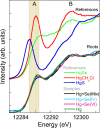Mercury speciation in selenium enriched wheat plants hydroponically exposed to mercury pollution
- PMID: 38036518
- PMCID: PMC10689832
- DOI: 10.1038/s41598-023-46056-5
Mercury speciation in selenium enriched wheat plants hydroponically exposed to mercury pollution
Abstract
Mercury (Hg) pollution in agricultural soils and its potential pathway to the human food chain can pose a serious health concern. Understanding the pathway of Hg in plants and how the speciation may change upon interaction with other elements used for biofortification can be critical to assess the real implications for the final plant-based product. In that respect, selenium (Se) biofortification of crops grown in Se-poor soil regions is becoming a common practice to overcome Se deficient diets. Therefore, it is important to assess the interplay between these two elements since Se may form complexes with Hg reducing its bioavailability and toxicity. In this work, the speciation of Hg in wheat plants grown hydroponically under the presence of Hg (HgCl2) and biofortified with Se (selenite, selenate, or a 1:1 mixture of both) has been investigated by X-ray absorption spectroscopy at the Hg L3-edge. The main Hg species found in wheat grains was the highly toxic methylmercury. It was found that the Se-biofortification of wheat did not prevent, in general, the Hg translocation to grains. Only the 1:1 mixture treatment seemed to have an effect in reducing the levels of Hg and the presence of methylmercury in grains.
© 2023. The Author(s).
Conflict of interest statement
The authors declare no competing interests.
Figures




References
-
- Morosini C, Terzaghi E, Raspa G, Zanardini E, Anelli S, Armiraglio S, Petranich E, Covelli S, Guardo AD. Mercury vertical and horizontal concentrations in agricultural soils of a historically contaminated site: Role of soil properties, chemical loading, and cultivated plant species in driving its mobility. Environ. Pollut. 2021;285:117467. doi: 10.1016/j.envpol.2021.117467. - DOI - PubMed
-
- Rodríguez-Martin JA, Gutiérrez C, Escuer M, Martín-Dacal M, Ramos-Miras JJ, Roca-Perez L, Boluda R, Nanos N. Trends in soil mercury stock associated with pollution sources on a Mediterranean island (Majorca, Spain) Environ. Pollut. 2021;283(15):117397. doi: 10.1016/j.envpol.2021.117397. - DOI - PubMed
MeSH terms
Substances
Grants and funding
- 754397 (DOC-FAM)/European Union's Horizon 2020 research and innovation program under the Marie Skłodowska-Curie grant agreements
- 665919 (P-Sphere)/European Union's Horizon 2020 research and innovation program under the Marie Skłodowska-Curie grant agreements
- 2018113213/ALBA facility for beamtime
- 2018123221/ALBA facility for beamtime
- 2019103977/ALBA facility for beamtime
LinkOut - more resources
Full Text Sources
Medical

